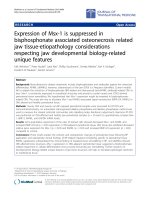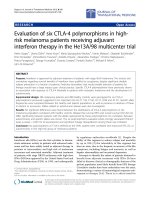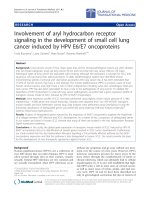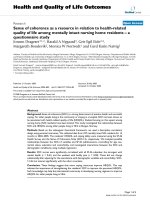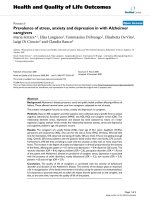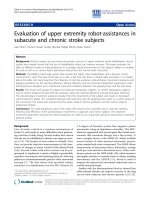Báo cáo hóa học: " Evidence of structural genomic region recombination in Hepatitis C virus" pdf
Bạn đang xem bản rút gọn của tài liệu. Xem và tải ngay bản đầy đủ của tài liệu tại đây (345.75 KB, 8 trang )
BioMed Central
Page 1 of 8
(page number not for citation purposes)
Virology Journal
Open Access
Research
Evidence of structural genomic region recombination in Hepatitis C
virus
Juan Cristina*
1
and Rodney Colina
1,2
Address:
1
Laboratorio de Virología Molecular, Centro de Investigaciones Nucleares, Facultad de Ciencias, Universidad de la República, Iguá 4225,
11400 Montevideo, Uruguay and
2
Department of Biochemistry and McGill Cancer Center, McGill University, Montreal, Quebec, H3G 1Y6,
Canada
Email: Juan Cristina* - ; Rodney Colina -
* Corresponding author
Abstract
Background/Aim: Hepatitis C virus (HCV) has been the subject of intense research and clinical
investigation as its major role in human disease has emerged. Although homologous recombination
has been demonstrated in many members of the family Flaviviridae, to which HCV belongs, there
have been few studies reporting recombination on natural populations of HCV. Recombination
break-points have been identified in non structural proteins of the HCV genome. Given the
implications that recombination has for RNA virus evolution, it is clearly important to determine
the extent to which recombination plays a role in HCV evolution. In order to gain insight into these
matters, we have performed a phylogenetic analysis of 89 full-length HCV strains from all types and
sub-types, isolated all over the world, in order to detect possible recombination events.
Method: Putative recombinant sequences were identified with the use of SimPlot program.
Recombination events were confirmed by bootscaning, using putative recombinant sequence as a
query.
Results: Two crossing over events were identified in the E1/E2 structural region of an intra-typic
(1a/1c) recombinant strain.
Conclusion: Only one of 89 full-length strains studied resulted to be a recombinant HCV strain,
revealing that homologous recombination does not play an extensive roll in HCV evolution.
Nevertheless, this mechanism can not be denied as a source for generating genetic diversity in
natural populations of HCV, since a new intra-typic recombinant strain was found. Moreover, the
recombination break-points were found in the structural region of the HCV genome.
Background
Hepatitis C virus (HCV) is estimated to infect 170 million
people worldwide and creates a huge disease burden from
chronic, progressive liver disease [1]. HCV has become a
major cause of liver cancer and one of the commonest
indications of liver transplantation [2,3]. HCV has been
classified in the family Flaviviridae, although it differs
from other members of the family in many details of its
genome organization from the original (vector-borne)
members of the family [1]. Like most RNA viruses, HCV
circulates in vivo as a complex population of different but
closely related viral variants, commonly referred to as a
quasispecies [4-7].
Published: 30 June 2006
Virology Journal 2006, 3:53 doi:10.1186/1743-422X-3-53
Received: 14 April 2006
Accepted: 30 June 2006
This article is available from: />© 2006 Cristina and Colina; licensee BioMed Central Ltd.
This is an Open Access article distributed under the terms of the Creative Commons Attribution License ( />),
which permits unrestricted use, distribution, and reproduction in any medium, provided the original work is properly cited.
Virology Journal 2006, 3:53 />Page 2 of 8
(page number not for citation purposes)
HCV is an enveloped virus with an RNA genome of
approximately 9400 bp in length. Most of the genome
forms a single open reading frame (ORF) that encodes
three structural (core, E1, E2) and seven non-structural
(p7, NS2-NS5B) proteins. Short unstranslated regions at
each end of the genome (5'NCR and 3'NCR) are required
for replication of the genome. This process also requires a
cis-acting replication element in the coding sequence of
NS5B recently described [8]. Translation of the single ORF
is dependent on an internal ribosomal entry site (IRES) in
the 5'NCR, which interacts directly with the 40S ribos-
omal subunit during translation initiation [9].
Comparison of nucleotide sequences of variants recov-
ered from different individuals and geographical regions
has revealed the existence of at least six major genetic
groups [1,10-12]. On the average over the complete
genome, these differ in 30–35% of nucleotide sites. Each
of the six major genetic groups of HCV contains a series of
more closely related sub-types that typically differ from
each other by 20–25 % in nucleotide sequences [12].
Different genotypes and sub-types seem to correlate differ-
ently for susceptibility to treatment with interferon (IFN)
monotherapy or IFN/ribavirin (RBV) combination ther-
apy. Only 10–20 % and 40–50 % of individuals infected
chronically with genotype 1 HCV on monotherapy and
combination therapy, respectively, exhibit complete and
permanent clearance of virus infection. These rates are
much lower than the rates of 50 and 70–80 % that are
observed on treatment of HCV genotype 2 or 3 infections
[3,13].
Until 1999, there was no evidence for recombination in
members of the family Flaviviridae, although the possibil-
ity was considered [14-16]. Accordingly, the vast majority
of work on members of this family, including vaccine
studies and phylogenetic analyses in which genotypes
were identified and sometimes correlated with disease
severity, has rested on the implicit assumption that evolu-
tion in the family Flaviviridae is clonal, with diversity gen-
erated through the accumulation of mutational changes
[17-19].
This assumption have shown to be invalid, as homolo-
gous recombination has been demonstrated in pestivi-
ruses,(bovine viral diarrhoea virus) [20], flaviviruses (all
four serotypes of dengue virus) [21-24], hepaciviruses (GB
virus C/hepatitis G virus) [25], Japanese encephalitis or St
Louis encephalitis virus [26].
Recombination plays a significant role in the evolution of
RNA viruses by creating genetic variation. For example,
the frequent recovery of poliovirus that result from recom-
Table 1: Full-length HCV sequences.
Name Genotype Accession number
H77 1a AF009606
HCV-H 1a M67463
COLONEL 1a AF290978
HC-J1 1a D10749
HCV-1HCV-PT 1a M62321
HCV-H 1a M67463
LTD1-2-XF222 1a AF511948
LTD6-2-XF224 1a AF511949
HC-J6 1a D00944
PHCV-1/SF9_A 1a AF271632
LTD6-2-XF224 1a AF511950
HEC278830 1a AJ238830
AB016785 1b AB016785
M1LE 1b AB080299
HCV-N 1b AF139594
MD1-0 1b AF165045
274933RU 1b AF176573
HCV-S1 1b AF356827
HCV-TR1 1b AF483269
HCV-A 1b AJ000009
HCV-AD78 1b AJ132996
HCV-AD78P1 1b AJ132997
NC1 1b AJ238800
HCR6 1b AY045702
HCV-S 1b AY460204
AY587016 1b AY587016
N589 1b AY587844
HC-C2 1b D10934
JT 1b D11168
J33 1b D14484
HPCPP 1b D30613
HCV-K1-R1 1b D50480
HCV-K1-R2 1b D50481
HCV-K1-R3 1b D50482
HCV-K1-S1 1b D50483
HCV-K1-S3 1b D50484
HCV-K1-S2 1b D50485
HCV-JS 1b D85516
D89815 1b D89815
HCV-J 1b D90208
HEBEI 1b L02838
HCV-BK 1b M58335
HPCGENANTI 1b M84754
HPCUNKCDS 1b M96362
HCV-N 1b S62220
HCU16362 1b U16362
HD-1 1b U45476
HCU89019 1b U89019
HPCHCPO 1b D45172
JK1-full 1b X61596
D89815 1b D89815
TMORF 1b D89872
HCV-O 1b AB191333
HD-1 1b U45476
Con1 1b AJ238799
HCV-L2 1b U01214
HCV-K1-S2 1b D50485
HEC278830 1b AJ238830
HCV-N 1b D63857
Virology Journal 2006, 3:53 />Page 3 of 8
(page number not for citation purposes)
bination has the potential to produce "escape mutants" in
nature as well as in experiments [27].
Recombination has also been detected in other RNA
viruses for which multivalent vaccines are in use or in tri-
als [21,24,28]. The potential for recombination to pro-
duce new pathogenic hybrid strains needs to be carefully
considered whenever vaccines are used or planned to con-
trol RNA viruses. Assumptions that recombination either
does not take place or is unimportant in RNA viruses have
a history of being proved wrong [24].
Recently, a natural intergenotypic recombinant (2k/1b) of
HCV has been identified in Saint Petersburg (Russia)
[29,30]. Phylogenetic analyses of HCV strains circulating
in Peru, demonstrated the existence of natural intra-geno-
typic HCV recombinant strains (1a/1b) circulating in the
Peruvian population [31].
Given the implications that recombination has for RNA
virus evolution [24], it is clearly important to determine
the extent to which recombination plays a role in HCV
evolution.
Results
Phylogenetic profile analysis of full-length HCV strains
To gain insight into possible recombination events, a phy-
logenetic profile analysis was carried out using 89 full-
length genome sequences from HCV isolates of all types
and sub-types (for strain names, accession numbers and
genotypes, see Table 1). This was done by the use of the
SimPlot program [32]. Interesting, when the analysis was
carried out for strain D10749 (sub-type 1A), two different
recombination points (detected at positions 1407 and
2050 of alignment) and two putative parental-like strains
(AF511949
, sub-type 1A and AY651061, sub-type 1C) are
observed (see Fig. 1).
In order to confirm these results, the same sequences were
used for a bootscanning study. The basic principle of
bootscanning is that mosaicism is suggested when one
observes high levels of phylogenetic relatedness between
a query sequence and more than one reference sequence
in different genomic regions [33]. When strain D10749
is
used as a query, this is observed for this strain and the two
putative parental-like strains previously detected (see Fig.
2). The same positions are also observed for the same
recombination break-points detected in the similarity
index study (see Figs. 1 and 2).
Profiles of synonymous and non-synonymous substitutions
among parental-like and recombinant HCV strains
To gain insight into how the recombination events may
have affected the mode of evolution of this HCV isolate,
the variation in the rates of synonymous (i.e. no amino
acid coding change) and nonsynonymous (i.e. changes in
the amino acid coding assignment) substitutions among
parental-like and the recombinant HCV strain were calcu-
lated for the genome region where the recombination
break-points were detected. Synonymous distances are
clearly significantly higher than nonsynonymous ones for
most of genome region analyzed (see Fig. 3). As a conse-
quence, the ratio of nonsynonymous-to-synonymous
amino acid substitutions (K
a
/K
s
) is very low for most of
this genomic region (see Fig. 3).
Interestingly, the rates of synonymous substitutions in
AY651016
–D10749 comparison are significantly lower in
the region spanned by the recombination break-points,
while significantly higher rates are obtained when
AF511949
–D10749 comparison is performed (see Fig. 3).
The results of these studies show that even though recom-
bination took place in the structural region of HCV
genome, is has not produced a drastic change in the mode
of evolution of the E1/E2 region, since the nonsynony-
mous substitution rate was maintained at very low rate
(see Fig. 3). Thus, at least on this basis, the E1/E2 genomic
region does not appear to have been perturbed by the
recombination event.
AY051292 1c AY051292
HC-G9 1c D14853
AY051292 1c AY05292
Khaja1 1c AY651061
pJ6CF 2a AF177036
MD2A-7 2a AF238485
JFH-1 2a AB047639
AY466460 2a AY746460
MD2B-1 2b AF238486
MD2b1-2 2b AY232731
HC-J8 2b D10988
JPUT971017 2b AB030907
BEBE1 2c D50409
VAT96 2k AB031663
HCVCENS1 3a X76918
CB 3a AF046866
K3A 3a D28917
HCVCENS1 3a X76918
NZL1 3a D17763
HCV-Tr 3b D49374
JK049 3k D63821
ED43 4a Y11604
EUH1480 5a Y13184
SA13 5a AF064490
6a33 6a AY859526
EUHK2 6a Y12083
TH580 6b D84262
VN235 6d D84263
JK046 6g D63822
VN004 6h D84265
VN405 6k D84264
KM45 6k AY878650
Table 1: Full-length HCV sequences. (Continued)
Virology Journal 2006, 3:53 />Page 4 of 8
(page number not for citation purposes)
Phylogenetic profiles of HCV sequencesFigure 1
Phylogenetic profiles of HCV sequences. In (A) results from SimPlot analysis are shown. The y-axis gives the percentage
of identity within a sliding window of 500 bp wide centered on the position plotted, with a step size between plots of 20 bp.
Comparison of HCV strain D10749 with strains AF511949 (sub-type 1A), AY651061 (sub-type 1C) and D45172 (sub-type 2B)
is shown. The red vertical lines show the recombination points at positions 1407 and 2050. In (B) a schematic representation
of the HCV genome is shown. Structural and non-structural regions of the genome are indicated on the top of the figure.
Nucleotide positions are shown by numbers on the upper part of the scheme. Amino acid codon positions are shown by num-
bers in the lower part of the scheme. No coding regions at the 5' and 3' of the genome are shown by a line. Coding region is
shown by a yellow rectangle, showing the corresponding proteins by name. Recombination points are shown by red arrows.
A
B
Structural Non-structural
Virology Journal 2006, 3:53 />Page 5 of 8
(page number not for citation purposes)
Discussion
In the present study, analysis of full-length sequences
from HCV strains of all types and sub-types provided the
opportunity to test the roll that recombination may play
in HCV genetic diversity.
The results of this study revealed that recombination may
not be extensive in HCV, since from 89 strains studied,
recombination was observed in only one case. This is in
agreement with the current methodology for HCV geno-
typing for the vast majority of the cases [10]. Nevertheless,
the true frequency of recombination may be underesti-
mated because although there is comparative important
number of complete genomes sequences from common
genotypes, such as 1b, most studies of HCV variability in
high diversity areas are based on analysis of single sub-
genomic regions, making detection of potential recombi-
nation events unlikely [10].
On the other hand, this study reveals that recombination
can not be denied as an evolutionary mechanism for gen-
erating diversity in HCV (see Figs. 1 and 2). Moreover, an
infectious HCV chimera comprising the complete open
reading frame of sub-type 1b strain and the 5'- and 3' non
translated regions of a sub-type 1a strain has been con-
structed and is infectious in vivo [34]. A natural inter-gen-
otype recombinant (2k/1b) has been identified in St.
Petersburg, Russia [29,30] and a natural intra-typic
recombinant (1a/1b) has been identified in Peru [31].
The recombination break-points for non-segmented posi-
tive-strand RNA viruses, such as polioviruses and other
picornaviruses [35-37] as well as members of the family
Flaviviridae, are often located in the part of the genome
encoding non structural proteins. More recently, recombi-
nation break-points have been found in genes encoding
structural proteins [38,39]. In the present study, we report
recombination events in structural genes (E1/E2 region)
between two different sub-types (1a/1c, see Figs. 1 and 2).
Recombination may serve two opposite purposes: explo-
ration of a new combination of genomic region from dif-
Bootscanning of HCV sequencesFigure 2
Bootscanning of HCV sequences. The y-axis gives the percentage of permutated trees using a sliding window of 500 bp
wide centered on the position plotted, with a step size between plots of 20 bp. The rest same as Fig.1A.
Virology Journal 2006, 3:53 />Page 6 of 8
(page number not for citation purposes)
ferent origins or rescuing of viable genomes from
debilitated parental genomes [40].
The recognition of recombination is important not only
for unraveling the phylogenetic history of genes, but also
for molecular phylogenetic inference. By ignoring the
presence of recombination, phylogenetic analysis may be
severely compromised [41,42]. For that reason, although
recombination may be not appeared to be extensive in
natural populations of HCV, this possibility should be
taken into account as a mechanism of genetic variation for
HCV.
The results of this study, as well as previous ones [29-31]
provide evidence that not only does recombination occurs
in HCV, but that it occurs in natural populations. In the
case of the recombinant described in this study, the distri-
bution of non-synonymous substitutions showed very
low rates, revealing that the E1/E2 region of this isolate
might have not been perturbed by the recombination
events (see Fig. 3). This may also be related to the fact that
the differences in this region of the genome among sub-
genotypes 1A and 1C, at least in the case of the isolates
involved in these studies, are not particularly significant at
the amino acid level in the genomic region where the
recombination events have occurred.
Conclusion
Only one of 89 full-length strains studied resulted to be a
recombinant HCV strain, revealing that homologous
recombination does not play an extensive roll in HCV
evolution. A new intra-typic (1a/1c) recombinant strain
was found. The recombination break-points were found
in the structural (E1/E2) region of the HCV genome.
Whether new HCV variants may appear, as a result of
recombination events, remains to be established as well as
if their fitness permits them to be selected in an HCV pop-
ulation.
Methods
Sequences
Full-length genome sequences from 89 HCV isolates
where obtained by means of the use of the HCV LANL
database [43]. For names, genotypes and accession num-
bers see Table 1. Sequences were aligned using the CLUS-
TAL W program [44].
Profiles of synonymous and nonsynonymous distances of parental-like versus recombinantFigure 3
Profiles of synonymous and nonsynonymous distances of parental-like versus recombinant. Numbers at the left
side of the figure denote distance. Numbers at the bottom of the figure show codon position in the mid point of the window.
Comparison AF511949-D10749 is shown in blue and light red for synonymous and nonsynonymous substitutions, respectively.
Comparison AY651061-D10749 is shown in yellow and light blue for synonymous and nonsynonymous substitutions, respec-
tively. Vertical red lines show recombination break-points positions.
0
0,2
0,4
0,6
0,8
1
1,2
225.5
345.5
465.5
585.5
705.5
825.5
945.5
1065.5
1185.5
1305.5
1425.5
1545.5
1665.5
1785.5
1905.5
2025.5
2145.5
2265.5
Virology Journal 2006, 3:53 />Page 7 of 8
(page number not for citation purposes)
Recombination analysis
Putative recombinant sequences were identified with the
SimPlot program [32]. This program is based on a sliding
window method and constitutes a way of graphically dis-
playing the coherence of the sequence relationship over
the entire length of a set of aligned homologous
sequences. The window width and the step size were set to
500 bp and 20 bp, respectively.
Bootscaning [33] was carried out employing software
from the SimPlot program [32], using putative recom-
binant sequence as a query. Mosaicism is suggested when
high levels of phylogenetic relatedness between the query
sequence and more than one reference sequence in differ-
ent genomic regions is obtained.
Substitution rate analysis
The substitution rate along the open reading frame of the
HCV genome, from position 1 to 2490 (relative to the first
coding position of strain D10749), was measured using a
sliding window method according to the procedure
implemented by Alvarez-Valin [45]. Pairwise nucleotide
distances (synonymous and nonsynonymous) within
each window were estimated by the method of Comeron
[46] as implemented in the computer program k-estima-
tor [47]. The window had a size of 150 codons and a
movement of 10.
Competing interests
The author(s) declare that they have no competing inter-
ests.
Authors' contributions
JC and RC conceived, designed and performed the analy-
sis. JC wrote the paper.
Acknowledgements
This work was supported by ICGEB, PAHO, and RELAB through Project
CRP.LA/URU03-032 and International Atomic Energy Agency through
project ARCAL 6050.
References
1. Simmonds P: Genetic diversity and evolution of hepatitis C
virus 15 years on. J Gen Virol 2004, 85:3173-3188.
2. Hoofnagle JH: Course and outcome of hepatitis C. Hepatology
2003, 36:S21-S29.
3. Pawlotsky JM: The nature of interferon-alfa resistance in hep-
atitis C virus infection. Curr Opin Infect Dis 2003, 16:587-592.
4. Chambers TJ, Fan X, Droll DA, Hembrador E, Slater T, Nickells MW,
Dustin LB, Dibisceglie AM: Quasispecies heterogeneity within
the E1/E2 region as a pretreatment variable during
pegylated interferon therapy of chronic hepatitis C virus
infection. J Virol 2005, 79:3071-3083.
5. Laskus T, Wilkinson J, Gallegos-Orozco JF, Radkowski M, Adair DM,
Nowicki M, Operskalsi E, Buskell Z, Seeff LB, Vargas H, Rakela J:
Analysis of hepatitis C virus quasispecies transmission and
evolution in patients infected through blood transfusion. Gas-
troenterology 2004, 127:764-776.
6. Feliu A, Gay E, Garcia-Retortillo M, Saiz JC, Foms X: Evolution of
hepatitis C virus quasispecies immediately following liver
transplantation. Liver Transpl 2004, 10:1131-1139.
7. Martell M, Esteban JL, Quer J, Genesca J, Weiner A, Esteban R, Guar-
dia J, Gomez J: Hepatitis C virus (HCV) circulates as a popula-
tion of different but closely related genomes: quasispecies
nature of HCV genome distribution. J Virol 1992, 66:3225-3229.
8. You S, Stump DD, Branch AD, Rice CM: A cis-acting replication
element in the sequence encoding the NS5B RNA-depend-
ent RNA polymerase is required for hepatitis C virus RNA
replication. J Virol 2004, 78:1352-1366.
9. Pestova TV, Shatsky IN, Fletcher SP, Jackson RJ, Hellen CUT: A
prokaryotic-like mode of cytoplasmic eukaryotic ribosome
binging to the initiation codon during internal translation ini-
tiation of hepatitis C and classical swine fever virus RNAs.
Genes Dev 1998, 12:6783.
10. Simmonds P, Bukh J, Combet C, Deleage G, Enomoto N, Feinstone S,
Halfon P, Inchauspe G, Kuiken C, Maertens G, Mizokami M, Murphy
DG, Okamoto H, Pawlotsky JM, Penin F, Sablon E, Shin- IT, Stuyver
LJ, Thiel HJ, Viazov S, Weiner AJ, Widell A: Consensus proposals
for a unified system of nomenclature of hepatitis C virus gen-
otypes. Hematology 2005, 42:962-973.
11. Simmonds P: The origin and evolution of hepatitis viruses in
humans. J Gen Virol 2001, 82:693-712.
12. Simmonds P, Holmes EC, Cha TA, Chan SW, McOmish F, Irvine B,
Beall E, Yap PL, Kolberg J, Urdea MS: Classification of hepatitis C
virus into six major genotypes and a series of subtypes by
phylogenetic analysis of the NS-5 region. J Gen Virol 1993,
74:2391-2399.
13. Zeuzem S: Heterogenous virologic response rates to inter-
feron-based therapy in patients with chronic hepatitis C:
who responds less well? Ann Intern Med 2004, 140:370-381.
14. Blok J, McWilliam SM, Butler HC, Gibbs AJ, Weiller G: Comparison
of a dengue-2 virus and its candidate vaccine derivative:
sequence relationships with the Flaviviruses and other
viruses. Virology 1992, 187:573-590.
15. Kuno G: Factors influencing the transmission of dengue
viruses. In Dengue and Dengue Haemorrhagic Fever Edited by: Gubler
DJ, Kuno G. Wallingford, UK: CAB International; 1997.
16. Monath TP: Dengue: the risk to developed and developing
countries. Proc Natl Acad Sci USA 1994, 91:2395-2400.
17. Chen WR, Tesh RB, Rico-Hesse R: Genetic variation of Japanese
encephalitis virus in nature. J Gen Virol 1990, 71:2915-2922.
18. Leitmeyer KC, Vaughn DW, Watts DM, Salas R, Villalobos de Chacon
I, Ramos C, Rico-Hesse R: Dengue virus structural differences
that correlate with pathogenesis. J Virol 1999, 73:4738-4747.
19. Rico-Hesse R: Molecular evolution and distribution of dengue
viruses type 1 and 2 in nature. Virology 1990, 174:479-493.
20. Becher P, Orlich M, Thiel H-J: RNA recombination between per-
sisting pestivirus and a vaccine strain: generation of
cytopathogenic virus and induction of lethal disease. J Virol
2001, 75:6256-6264.
21. Holmes EC, Worobey M, Rambaut A: Phylogenetic evidence for
recombination in dengue virus. Mol Biol Evol 1999, 16:405-409.
22. Tolou H, Couissinier-Paris P, Durand JP, Mercier V, de Pina JJ: Evi-
dence for recombination in natural populations of dengue
virus type 1 based on the analysis of complete genome
sequences. J Gen Virol 2001, 82:1283-1290.
23. Uzcategui NY, Camacho D, Comach G, Cuello de Uzcategui R, Hol-
mes EC: The molecular epidemiology of dengue type 2 virus
in Venezuela: evidence for in situ virus evolution and recom-
bination. J Gen Virol 2001, 82:2945-2953.
24. Worobey M, Holmes EC: Evolutionary aspects of recombina-
tion in RNA viruses. J Gen Virol 1999, 80:2535-2543.
25. Worobey M, Holmes EC: Homologous recombination in GB
virus C/hepatitis G virus. Mol Biol Evol 2001, 18:254-261.
26. Twiddy SS, Holmes EC: The extent of homologous recombina-
tion in members of the genus Flavivirus. J Gen Virol 2003,
84:429-440.
27. Kew OM, Nottay BK: Evolution of the oral polio vaccine strains
in humans occurs by both mutation and intra-molecular
recombination. In Modern Approaches to Vaccines Edited by:
Chanock RM, Lerner RA. Cold Spring Harbor, NY: Cold Spring Har-
bor Laboratory; 1984:357-363.
28. Suzuki Y, Gojobori T, Nakagomi O: Intragenic recombinations in
rotaviruses. FEBS Lett 1998, 427:183-187.
29. Kalinina O, Norder H, Magnius O: Full-length open reading
frame of a recombinant hepatitis C virus strain from St.
Publish with BioMed Central and every
scientist can read your work free of charge
"BioMed Central will be the most significant development for
disseminating the results of biomedical research in our lifetime."
Sir Paul Nurse, Cancer Research UK
Your research papers will be:
available free of charge to the entire biomedical community
peer reviewed and published immediately upon acceptance
cited in PubMed and archived on PubMed Central
yours — you keep the copyright
Submit your manuscript here:
/>BioMedcentral
Virology Journal 2006, 3:53 />Page 8 of 8
(page number not for citation purposes)
Petersburg: proposed mechanism of its formation. J Gen Virol
2004, 85:1853-1857.
30. Kalinina O, Norder H, Mukomolov S, Magnius LO: A natural
intergenotypic recombinant of hepatitis C virus identified in
St. Petersburg. J Virol 2002, 76:4034-4043.
31. Colina R, Casane D, Vasquez S, Garcia-Aguirre L, Chunga A, Romero
H, Khan B, Cristina J: Evidence of intratypic recombination in
natural populations of hepatitis C virus. J Gen Virol 2004,
85:31-37.
32. Lole KS, Bollinger RC, Parnjape RS, Gadkari D, Kulkarni SS: Full-
length human immunodeficiency virus type 1 genomes from
subtype C-infected seroconverters in India, with evidence of
intersubtype recombination. J Virol 1999, 73:152-160.
33. Salminen MO, Carr JK, Burke DS, McCutchan FE: Identification of
breakpoints in intergenotypic recombinants of HIV type 1 by
bootscanning. AIDS Res Hum Retroviruses 1995, 11:1423-1425.
34. Yagani M, St Claire M, Shapiro M, Emerson SU, Purcell H: Tran-
scripts of a chimeric cDNA clone of hepatitis C virus geno-
type 1b are infectious in vivo. Virology 1998, 244:161-172.
35. Santti J, Hyypia T, Kinnunen L, Salminen M: Evidence of recombi-
nation among enteroviruses. J Virol 1999, 73:8741-8749.
36. Guillot S, Caro V, Cuervo N, Korotkova E, Combiescu M: Natural
genetic exchanges between vaccine and wild poliovirus
strains in humans. J Virol 2000, 74:8434-8443.
37. Kew O, Morris-Glasgow V, Landaverde M, Burns C, Shaw J, Garib Z,
Andre J, Blackman E, Freeman CJ, Jorba J, Sutter R, Tambini G, Venc-
zel L, Pedreira C, Laender F, Shimizu H, Yoneyama T, Miyamura T, van
Der Ayoort H, Oberste MS, Kilpatrick D, Cochi S, Pallansch M, de
Quadros C: Outbreak of poliomyeolitis in Hispaniola associ-
ated with circulating type 1 vaccine-derived poliovirus. Sci-
ence 2002, 296:356-359.
38. Costa-Mattioli M, Ferre V, Casane D, Perez-Bercoff R, Coste-Burel
M, Imbert-Marcille BM, Andre EC, Bresollette-Bodin C, Billaudel S,
Cristina J: Evidence of recombination in natural populations of
hepatitis A virus. Virology 2003, 311:51-59.
39. Martin J, Samoilovich E, Dunn G, Lackenby A, Feldman E, Heath A,
Svirchevskaya E, Cooper G, Yermalovich M, Minor PD: Isolation of
an intertypic poliovirus capsid recombinant from a child with
vaccine-associated paralytic poliomyelitis. J Virol 2002,
76:10921-10928.
40. Domingo E, Holland JJ: RNA virus mutations and fitness for sur-
vival. Annu Rev Microbiol 1997, 51:151-178.
41. Posada D, Crandall KA: Evaluation of methods for detecting
recombination from DNA sequences: Computer simula-
tions. Proc Natl Acad Sci USA 2001, 98:13757-13762.
42. Schierup MH, Hein J: Consequences of recombination on tradi-
tional phylogenetic analysis. Genetics 2000, 156:879-891.
43. Kuiken C, Yusim K, Boykin L, Richardon R: The HCV Sequence
Database. Bioinformatics 2005, 21:379-384.
44. Thompson JD, Higgins DG, Gibson TJ: CLUSTAL W: improving
the sensitivity of progressive multiple sequence alignment
through sequence weighting, position-specific gap penalties
and weight matrix choice. Nucleic Acid Res 1994, 22:4673-4680.
45. Alvarez-Valin F, Tort JF, Bernardi G: Nonrandom spatial distribu-
tion of synonymous substitutions in the GP63 gene from
Leishmania. Genetics 2000, 155:1683-1692.
46. Comeron JM: A method for estimating the numbers of synon-
ymous and nonsynonymous substitutions per site. J Mol Evol
1995, 41:1152-1159.
47. Ina Y, Gojobori T: Statistical analysis of nucleotide sequences
of the hemagglutinin gene of human influenza A viruses. Proc
Natl Acad Sci USA 1994, 91:8388-8392.


